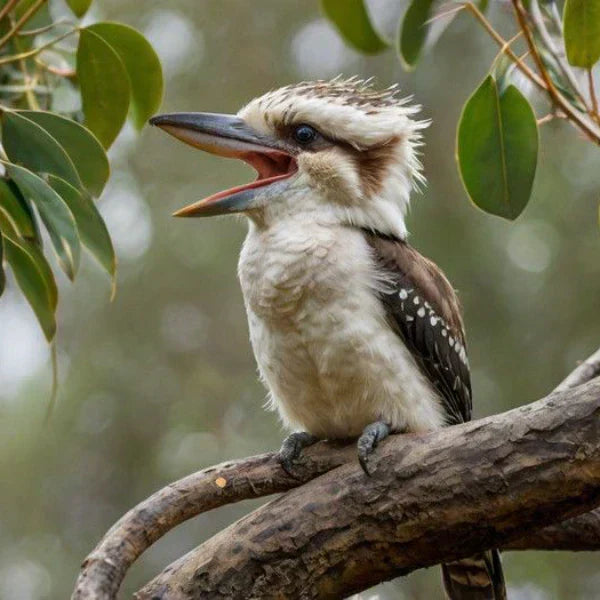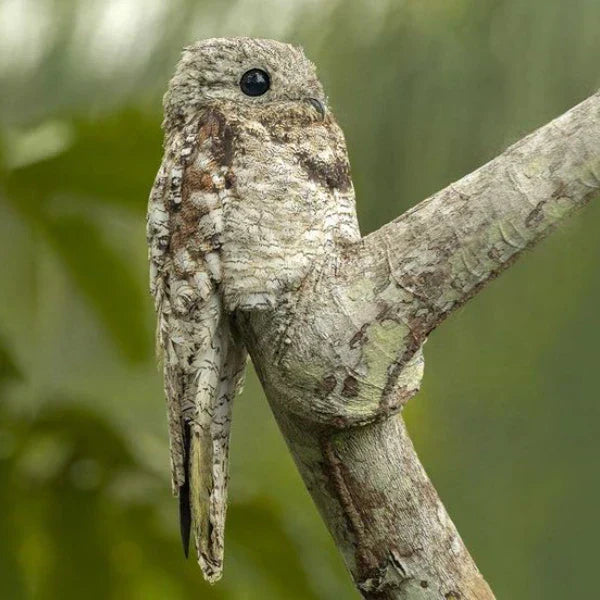If you even hear a loud, echoing laugh bouncing through the trees, it's likely a kookaburra. They're typically found in the forests of Eastern and Western Australia and are known as nature's most cheerful alarm clock.
From its clever hunting style to its close family bonds, the laughing kookaburra is full of surprises. It's not only a top predator in its habitat but also plays an important role in maintaining balance in the ecosystem.
In this article, we'll explore what makes the laughing kookaburra so special: its behavior, habitat, diet, and the science behind its iconic "laugh".
What is a Laughing Kookaburra (Dacelo novaeguineae)?
The laughing kookaburra is one of the most iconic birds in Australia. It's instantly recognizable by its hearty, human-like call that sounds uncannily like a burst of laughter — more fitting for a jungle movie than real life.
Despite being part of the kingfisher family (Alcedinidae), the laughing kookaburra is quite different from other water-loving kingfishers. Its feathers are predominantly cream and brown, with dark brown markings on the wings and around the eyes that give it its rugged look.

Growing up to 45 cm (18 inches) in length, the laughing kookaburra is the largest member of the kingfisher family. It has a large head and a strong beak, perfect for catching and swallowing small prey whole.
Native to eastern Australia, the bird has also been introduced to other parts of the country, including the southwest corner and even New Zealand.
Other Kookaburra Species
While there's only one true laughing kookaburra, the kookaburra family includes a few other species that share similar traits but have different calls and live in different areas:
- Blue-Winged Kookaburra (Dacelo leachii): They are found in northern Australia and New Guinea. Blue-winged kookaburras have bright blue wings and white tips and are known for producing a more screech-like territorial call.

- Rufous-Bellied Kookaburra (Dacelo gaudichaud): This bird has a reddish belly.

- Spangled Kookaburra (Dacelo tyro): Also from New Guinea, the spangled kookaburra has dark eyes and wings with pale blue patches. However, it is much less studied than the laughing kookaburra.

Why Do Kookaburras Laugh?
The kookaburra's laugh might sound like a good old chuckle, but it's not because the bird just heard a funny joke. That iconic call is all about communication, territory, and social bonding.
When a kookaburra "laughs", it's usually saying something like, "This is my spot—stay out!" These vocal calls help family groups mark their territory, especially during dawn and dusk. That's why you often hear their chorus early in the morning.

Where Do Laughing Kookaburras Live?
These birds exist in various parts of the world, such as western and southern Australia, Tasmania, and even New Zealand, where it was introduced in the early 1900s.
These birds are very adaptable and don't need fancy forests for food or untouched wilderness to survive. You'll find these birds in a variety of habitats, including:
- Eucalyptus forests: Their natural and preferred environment.
- Open woodlands and bushlands: Perfect for hunting from tree branches.
- Farmlands and rural areas: They often perch on fences or posts, scanning for prey.
- Suburban neighborhoods: Surprisingly common in gardens and parks.
- Golf courses and schoolyards: Anywhere with tall trees and open spaces.

What Do Laughing Kookaburras Eat?
Despite their cheerful laugh and calm look, laughing kookaburras are actually skilled predators and mostly feed on small prey. Their diet might surprise you, as these birds are not pecking at seeds or feeding on berries. Instead, they're on the hunt for real and live prey.
Kookaburras are carnivores, and some of their favorite foods include:
- Small snakes and reptiles, like skinks, geckos, and even baby snakes.
- Large insects, such as grasshoppers, beetles, and cicadas.
- Worms and grubs, especially after the rain.
- Small birds and baby chicks, like parrots, sometimes even from other nests.
- Rodents and mice, when they can catch them.
- Frogs and small amphibians.

Family Life: Monogamy and Teamwork
Laughing kookaburras aren't only skilled hunters but also incredibly loyal and family-focused. These birds form strong, monogamous pairs that often stay together for life. They live in family groups, where older siblings born in the last breeding season stick around to help their parent birds. This behavior, known as cooperative breeding, is quite unique and has been researched extensively by experts, including researchers from Oxford University Press.
In a typical kookaburra family group, you'll find:
- A breeding pair (the parents).
- Helpers, usually older offspring who stay behind to support.
- New chicks being raised in the same nest.

Breeding Season
Laughing kookaburras usually breed during the Australian spring and early summer, from September to January.
The female lays 2 to 4 eggs in a tree hollow or in an arboreal termite nest. Both adult males and females share incubation duties, taking turns keeping the eggs warm. Once the white eggs hatch, the whole family helps with the parenting duties.
Cultural Significance and Fun Facts
The laughing kookaburra is a national symbol, a part of Aboriginal culture, and a familiar voice in many people's childhood memories. With its unforgettable, distinctive laugh and bold personality, the kookaburra has found a special place in both tradition and pop culture.
In Aboriginal Culture
For many Aboriginal groups, the kookaburra holds spiritual significance. Some Dreamtime stories say the bird's laugh was the signal to the sky spirits to light the sun each morning.
Its call was believed to bring warmth and daylight — a natural alarm clock with deep meaning.

An Aussie Icon
Australians love the kookaburra. Many logos, cartoons, and sports teams use it as a mascot. It also appears on postage stamps, with many people around the world considering it a famous symbol of the Australian bush.
Fun and Quirky Facts
Some fun and quirky facts about laughing kookaburras are:
- Kookaburras don't drink water often, as they get most of it from their food.
- Their laugh sounds cheerful, but it's actually a territorial warning.
- Despite being kingfishers, they rarely eat fish.
- In the 2000 Sydney Olympics, a kookaburra named "Olly" became a star.
Are Laughing Kookaburras Endangered? Conservation Status
The laughing kookaburra is currently classified as a species of "Least Concern" by the International Union for Conservation of Nature (IUCN). This classification indicates that the species is not at immediate risk of extinction and enjoys a relatively stable population.

Population Estimates
Estimating the exact population of laughing kookaburras is challenging due to their wide distribution and adaptability to various habitats. However, some sources suggest that the population could be as high as 65 million individuals.
In New Zealand, where these birds were introduced later, their population is much smaller with fewer than 500 individuals.
Threats to Their Population
While laughing kookaburras are not currently endangered, they do face certain threats that could impact their populations in the future:
- Habitat Loss: With 620,000 hectares of land lost every year in Australia, it can reduce the availability of suitable nesting sites and hunting grounds for kookaburras.
- Poisoning from Pesticides: The use of pesticides can lead to secondary poisoning, affecting kookaburras that consume contaminated prey.
- Predation by Introduced Species: In regions where non-native predators like cats, foxes, and large owls are present, kookaburras, especially juveniles, may be at increased risk.

How to Spot or Hear a Laughing Kookaburra
If you're hoping to see — or hear — a laughing kookaburra in the wild, you're in luck. However, you might have to travel to western and southern regions, Tasmania, or New Zealand, as they are mostly seen there.
Here are some quick bird-watching tips for you:
- Stay quiet and move slowly, as kookaburras can be startled by sudden noise.
- Bring binoculars to watch them closely without getting too near.
- Look up and listen to their perch, as it's often high and their call travels far.
- Go out early in the morning or late afternoon for the best chances.
Final Thoughts
The laughing kookaburra is much more than just a bird with a large bill and a funny call. It's a skilled hunter, a loyal family member, and a symbol of Australia's wild beauty.
From its laugh to its clever hunting and tight-knit family life, every part of the kookaburra's world is worth discovering.
Whether you're spotting one in your backyard or hearing its call in the distance, the kookaburra always leaves a lasting impression.

FAQs
1. How many laughing kookaburras are there?
According to recent data, there are over 65 million laughing kookaburra individuals all over the world, with less than 500 in New Zealand. These birds are not endangered and remain widespread in many parts of the country.
2. Why Is the Laughing Kookaburra Special to Australia?
The laughing kookaburra is a national icon in Australia. Known for its loud, laugh-like call, it's often seen as a symbol of the Australian bush. It also plays a key role in ecosystems by helping control pests like snakes, insects, and small rodents.
3. Are Laughing Kookaburras Friendly Toward Humans?
Kookaburras are known to be bold and curious, especially in places where they're used to people. While they aren't exactly pets, they often visit backyards and parks and may even snatch food if given the chance.
4. What Do Laughing Kookaburras Eat in the Wild?
Laughing Kookaburras are carnivorous hunters. They eat a variety of prey, including:
- Insects like grasshoppers and beetles
- Small reptiles such as lizards and baby snakes
- Frogs, worms, and rodents
- Small birds or chicks from nests




Leave a comment
All comments are moderated before being published.
This site is protected by hCaptcha and the hCaptcha Privacy Policy and Terms of Service apply.